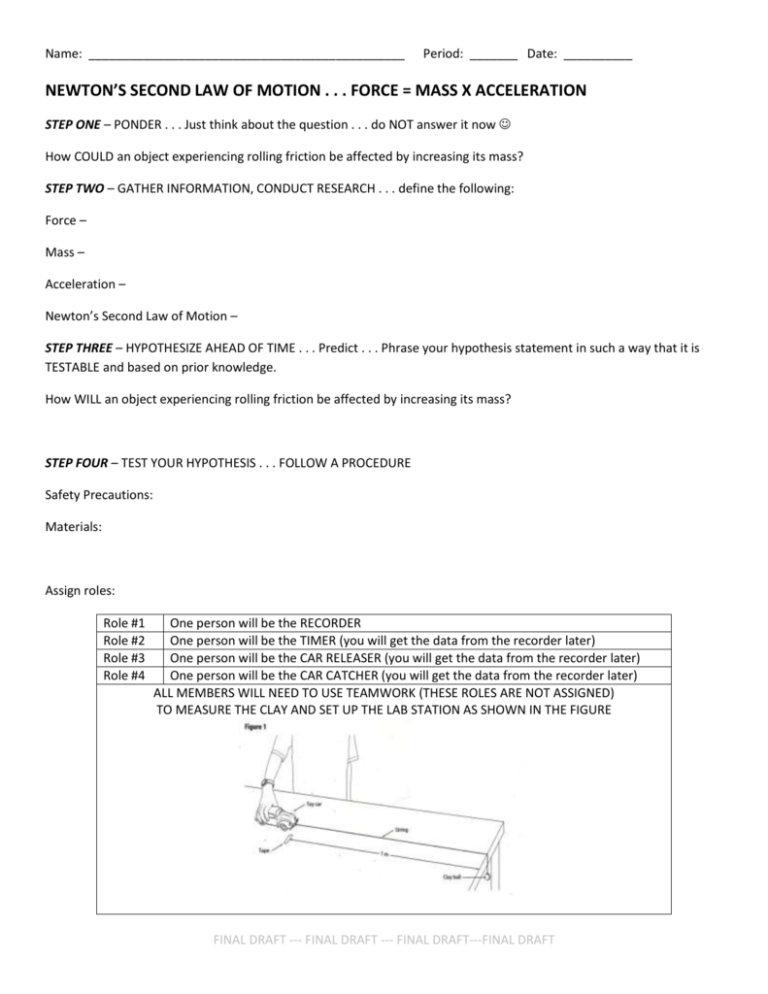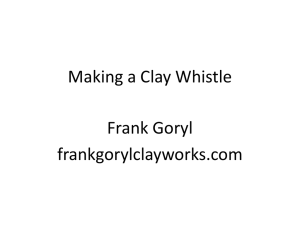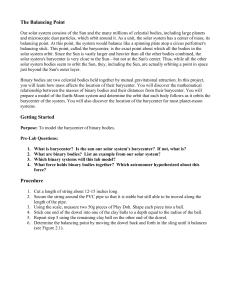newton`s second law of motion . . . force = mass x
advertisement

Name: ______________________________________________ Period: _______ Date: __________ NEWTON’S SECOND LAW OF MOTION . . . FORCE = MASS X ACCELERATION STEP ONE – PONDER . . . Just think about the question . . . do NOT answer it now How COULD an object experiencing rolling friction be affected by increasing its mass? STEP TWO – GATHER INFORMATION, CONDUCT RESEARCH . . . define the following: Force – Mass – Acceleration – Newton’s Second Law of Motion – STEP THREE – HYPOTHESIZE AHEAD OF TIME . . . Predict . . . Phrase your hypothesis statement in such a way that it is TESTABLE and based on prior knowledge. How WILL an object experiencing rolling friction be affected by increasing its mass? STEP FOUR – TEST YOUR HYPOTHESIS . . . FOLLOW A PROCEDURE Safety Precautions: Materials: Assign roles: Role #1 Role #2 Role #3 Role #4 One person will be the RECORDER One person will be the TIMER (you will get the data from the recorder later) One person will be the CAR RELEASER (you will get the data from the recorder later) One person will be the CAR CATCHER (you will get the data from the recorder later) ALL MEMBERS WILL NEED TO USE TEAMWORK (THESE ROLES ARE NOT ASSIGNED) TO MEASURE THE CLAY AND SET UP THE LAB STATION AS SHOWN IN THE FIGURE FINAL DRAFT --- FINAL DRAFT --- FINAL DRAFT---FINAL DRAFT Name: ______________________________________________ Period: _______ Date: __________ Procedure: 1. Cut a piece of string 120 cm long. Tie a two to three knots in one end of the string. 2. Make a small ball of class with a mass of 20 g. Attach this ball of clay to the string by folding the clay around the loop. The knots will help prevent the clay ball from falling off the string. 3. Divide the remaining clay into FIVE pieces, each with a mass of 40 g. 4. Using the triple beam balance, measure the mass of the toy car and record the mass in the data table. 5. Use the meterstick to find a spot on the table 1 meter from the edge. Mark it with a small piece of tape. This will be the starting point for the toy car during the experiment. Your set-up should look like the figure above. Be certain there are no obstacles in the way of the car OR the clay ball at the end of the string that will have to be able to fall freely as it will be providing the force in this experiment. 6. Put the front of the toy car at the starting point. Hold the piece of string on the table so that the clay ball is about 5 to 6 cm over the edge. Attach the other end of the string to the toy car. Trim any excess string so that it does not interfere with the motion of the car in any way. PRACTICE A FEW TIMES RELEASING AND CATCHING THE CAR TO MAKE SURE THE STRING ISN’T IN THE WAY AND EVERYONE UNDERSTANDS THEIR ROLES. 7. To gather actual data, the group needs to work together to RELEASE the car, TIME the trial, CATCH the car, and RECORD the TIMES for each trial. Several TIME trials will need to be done to complete the data table provided. 8. Read #5 of Step 7 – Drawing Conclusions and complete PRIOR to cleaning up. STEP 5 – GATHER DATA Mass of the car = __________ g Mass (g) Total mass of clay TOTAL mass of ON top of the car clay AND car 0 40 80 120 160 Travel Time (s) Conduct all three time trials BEFORE adding more clay Time 1 Time 2 Time 3 Average Time (T1) (T2) (T3) (T1+T2+T3)/3 STEP 6 – ANALYZE DATA – Graph your data, include a TITLE, axis labels, use proper intervals on each axis as well. FINAL DRAFT --- FINAL DRAFT --- FINAL DRAFT---FINAL DRAFT Name: ______________________________________________ Period: _______ Date: __________ STEP 7 – DRAW CONCLUSIONS . . . Use complete sentence that include supporting data from your experiment. 1. Discuss the materials used during this lab. Specifically identify the following: source of the force (be careful), source of the mass, source of the acceleration. 2. How DID increasing the mass of an object experiencing rolling friction be affected by increasing its mass? 3. Explain how your data supports Newton’s Second Law of Motion. 4. Why is it important to average THREE travel times for each one of the total masses? 5. What were some possible sources of ERROR in this lab? What things might have caused differences in travel time for the same mass? 6. Use the data you collected and the graph to PREDICT how much mass would be necessary to cause travel time of 15 seconds. Be very specific. FINAL DRAFT --- FINAL DRAFT --- FINAL DRAFT---FINAL DRAFT



![[1.1] Prehistoric Origins Work Sheet](http://s3.studylib.net/store/data/006616577_1-747248a348beda0bf6c418ebdaed3459-300x300.png)



